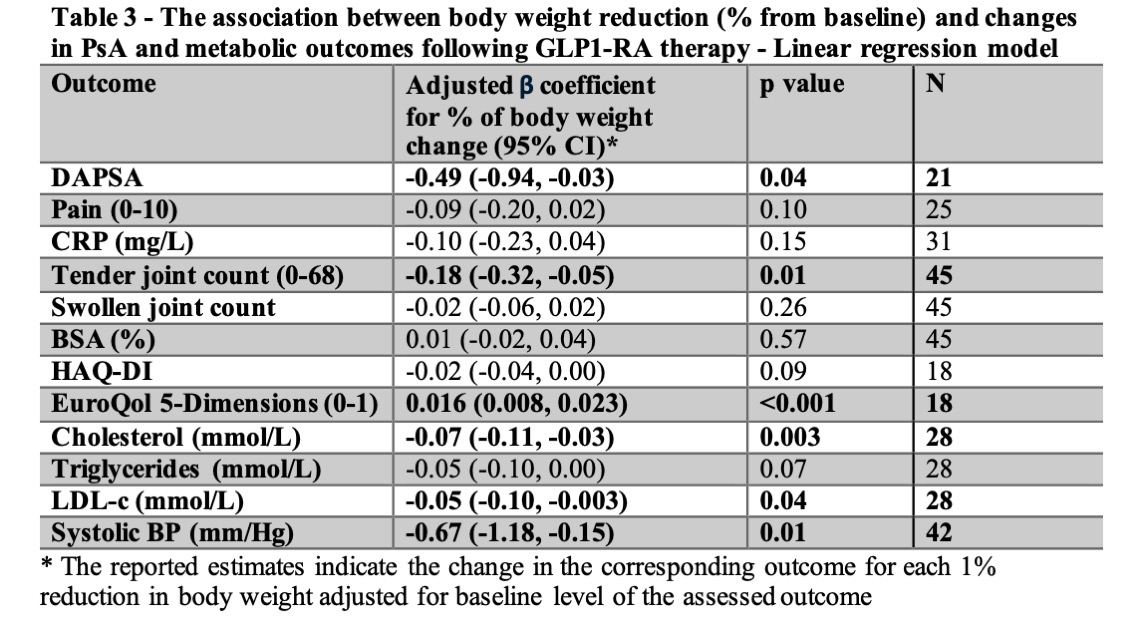All News
Stopping therapy in GCA
They say the easiest bit about GCA, like PMR, is the first week after you start steroids. Those fond memories belie the challenge of ongoing treatment in GCA. In a steroid-only world, there is only misery. Steroid-sparing therapies have changed this completely.
Read Article
#PD1 Ab looks good and safe in active RA
Rosnilimab, a Selective and Potent Depleter of Pathogenic T
Many failed several Rx already
No safety signals compared to another PD1i
Proof of benefit in biospecimens too!
abst#LB19 #ACR25 @RheumNow @ACRheum
#ACRBest https://t.co/TmEOCfuHZU
Links:
Janet Pope Janetbirdope ( View Tweet)

Biologic choice in PsA: consider factoring in obesity ⚖️
Abstract 2691: In a longitudinal cohort study, obesity associated with ↓ odds of achieving minimal disease activity (MDA) among pts on TNFi, but not with other DMARDs
@RheumNow #ACR25 https://t.co/p4KaH6HKYj
Akhil Sood MD, MS AkhilSoodMD ( View Tweet)

#2661 In >5000 veterans with RA-ILD, 8 distinct FVC trajectories were identified. >1/2showed a progressive decline (≥0.7%/yr). These progressive patterns predicted higher mortality & respiratory hospitalisations, underscoring major disease heterogeneity. @RheumNow #ACR25
Mrinalini Dey DrMiniDey ( View Tweet)

TAC+MMF + GC vs TAC +GC in lupus nephritis (target trial emulation):
🔹Higher total renal response w/ TAC + MMF + GC at 12 mo (59.7% vs 33.3%) consistent in ITT & per-protocol
🔹similar adverse events reported (14.6% vs 16.4%)
@RheumNow #ACR25 https://t.co/Yuql3O9C8X
Akhil Sood MD, MS AkhilSoodMD ( View Tweet)

Abstract 2690: Food as a Medicine
Mediterranean vs low-calorie DASH vs control diet in PsA (multicenter RCT):
🔹 All 3 groups showed significant weight loss & DAPSA by wk 24
🔹 Weight loss not diet type may be the driver of clinical improvement
@RheumNow #ACR25 https://t.co/rBS3HR1HXl
Akhil Sood MD, MS AkhilSoodMD ( View Tweet)

#2702 @ClevelandClinic Vascular ultrasound (VUS) for suspected GCA showed excellent specificity (100%) but low sensitivity (21%) compared with 6m confirmed diagnosis.
Fair agreement with TAB (κ=0.64).
Findings highlight need for standardised VUS protocols in US. @RheumNow #ACR25 https://t.co/LRFpFBnWWz
Mrinalini Dey DrMiniDey ( View Tweet)

Older Adults Underrepresented in RCTs
Drs. Jiha Lee and Sebastian Sattui discuss abstract 1072, "Inclusion of Older Adults in Pharmacologic Randomized Controlled Clinical Trials of Autoimmune Rheumatic Diseases: A Systematic Review," presented at #ACR25
https://t.co/uzSPH5RbjM https://t.co/94Vw6qUOIL
Dr. John Cush RheumNow ( View Tweet)

Sooner May Still Be Too Late: Kidney Biopsies in SLE
#ACR25 kicked off with Plenary Session by Michelle Petri (Abstract 0772: Redefining When to Biopsy the Kidney in Patients with SLE. As part of a collaboration with the Accelerating Medicines Partnership, Petri and colleagues https://t.co/bU09vpcDew
Dr. John Cush RheumNow ( View Tweet)

In a 5-year EHR-based cohort, PsO patients initiating IL-17i had significantly lower incidence of PsA/IA vs IL-23i, IL-12/23i, or TNFi. IL-17i reduced time with PsA/IA by 45% vs IL-23i, 61% vs IL-12/23i, and 74% vs TNFi. Further research need investigate if IL-17i may delay https://t.co/0PTbXZpLbu
Antoni Chan MD (Prof) synovialjoints ( View Tweet)

#ACR25 Abstr#2695 Inguinal lymph node biopsies pre- and post-OBI, RTX, BLIN & CD19 CAR-T showed complete tissue depletion with CAR-T. B-cells reduced but often incomplete with protein-based depleters; OBI being the best. Still don’t agree with “immune reset” @RheumNow #ACRBest https://t.co/Sq7m9sXlLP
Links:
Md Yuzaiful Md Yusof Yuz6Yusof ( View Tweet)

#2660 In >8000 women, serum urate rose sharply during the menopausal transition, then plateaued after menopause.
Hyperuricemia reached 4-5% post-menopause, up to 18% in obesity or low eGFR.
Healthy body weight & kidney function pre-menopause may decrease HU later @RheumNow #ACR25 https://t.co/v6ai3lgAd2
Mrinalini Dey DrMiniDey ( View Tweet)

#2682 In a randomised trial of 320 RA patients, the recombinant zoster vaccine (RZV) was safe and did not trigger disease flares. But methotrexate use and older age significantly blunted antibody responses ➡️key factors to consider for vaccine strategies in RA. @RheumNow #ACR25
Mrinalini Dey DrMiniDey ( View Tweet)

kids w
👇
Undifferentiated #systemic #autoinflammatory #disease
Rx #IL1i
N=33
=boys &girls 3.5 yrs Sx
Abst#2151
#ACR25 @ACRheum @RheumNow
There are many periodic fever syndromes
🤔some mutations are not yet discovered
Access to &use of
Anakinra
canukinumab
Rilonacept https://t.co/IyTx0nFxKC
Janet Pope Janetbirdope ( View Tweet)

#2659 In a large real-world target trial (>1.3M with T2D), SGLT2 inhibitors, esp dapagliflozin & empagliflozin, were assoc with lower risks of RA, lupus, vasculitis & other autoimmune rheumatic diseases vs DPP-4 inhibitors. Possible immune benefits of SGLT2i? @RheumNow #ACR25
Mrinalini Dey DrMiniDey ( View Tweet)

#ACR25 Please find my video summary on the Phase 3 RCTs results of Ianalumab in moderate to severe disease activity in #Sjogren Disease presented during Late Breaking Abstract session Abstr#LB24 #SjD @RheumNow
https://t.co/ngCAglwAO0 https://t.co/PaUYsxhBKS
Links:
Md Yuzaiful Md Yusof Yuz6Yusof ( View Tweet)

Abstract 2697: Compared to MMF, tacrolimus showed
- similar SRR by week 96 (58.5% vs. 69.2%, OR 0.62; 95% CI 0.29-1.29)
- similar time to renal AE/deaths (HR 0.70; 95% CI 0.37-1.35)
- serious AEs less frequent (12.3% vs. 30.8%)
@RheumNow #ACR25 https://t.co/o3LtgOp7St
Akhil Sood MD, MS AkhilSoodMD ( View Tweet)

In PsA patients, GLP-1 RA therapy led to significant weight loss and improvements in CRP, pain, lipids, and blood pressure. PsA outcomes improved proportionally with weight loss. Regression analyses revealed that each 1% reduction in body weight was associated with significant https://t.co/Pph1PjfOve
Antoni Chan MD (Prof) synovialjoints ( View Tweet)

Abstract 2696: Phase 1/2 study of rapidly engineered CD19 CAR T showed:
- rapid depletion of CD19 B cells w/ recovery by Day 90
- Days 180 and 360: returning B cells largely naive (CD27-IgD+)
- Interferon expression ↓ after CAR T treatment
@RheumNow #ACR25 https://t.co/FzdFbqWwtE
Links:
Akhil Sood MD, MS AkhilSoodMD ( View Tweet)

#ACR25 Abstr#2697 H2H RCT of Tacrolimus + GC vs MMF + GC in #lupus Nephritis in Asia for Induction-Maintenance showed similar efficacy. Different side effects: AKI more in TAC, low WCC & infections in MMF. Informative for services with no access to biologics/Voclosporin @RheumNow https://t.co/V4uWhuqjjW
Md Yuzaiful Md Yusof Yuz6Yusof ( View Tweet)




